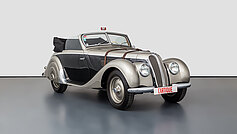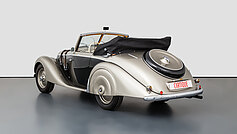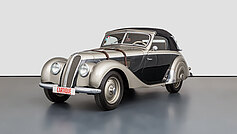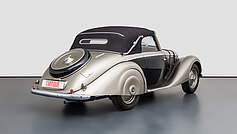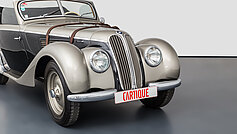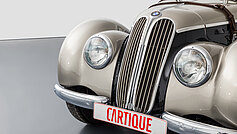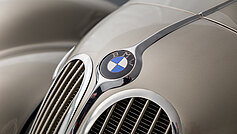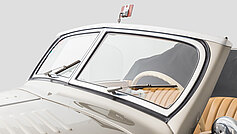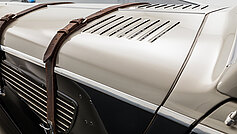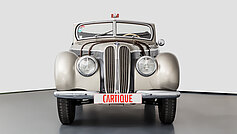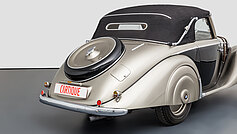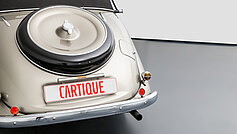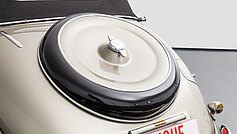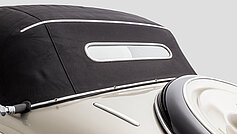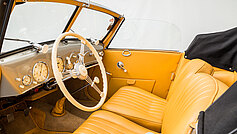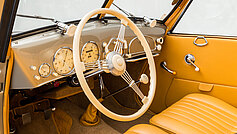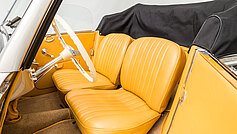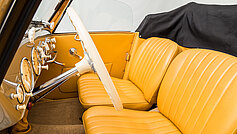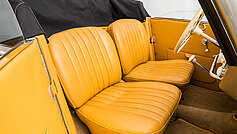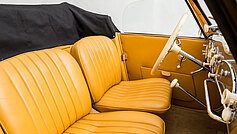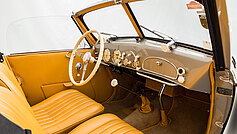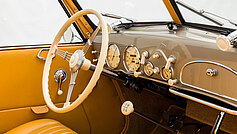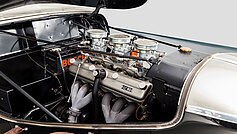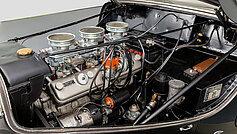BMW 328 Wendler Sport Cabriolet
- Very rare Wendler body
- Elaborate full restoration
- Extensive documentation
| Year: | 1940 |
|---|---|
| Paintwork: | Black-grey |
| Interior: | Leather brown |
| Gearing Type: | Manual |
| Mileage: | 17.122 KM |
|---|---|
| Power: | 80 HP |
| Fuel*: | Petrol |
| Price: | 619.000,- € (Tax paid) |
* Fuel consumption: (DIN 70030) 15,3 L Super determined at 3/4 of maximum speed, maximum of 110 km / h below surcharge of 10% (factory specification)
Get in touch with OUR SALES STAFF FOR THE BMW 328 Wendler Sport Cabriolet.
The BMW 328 Wendler Sport Cabriolet
The BMW 328 was a sports car made by Bayerische Motoren Werke. The roadster built in Eisenach was seen for the first time at the 1936 Eifel race on the Nordschleife of the Nürburgring, where it won the sports car class up to 2000 cc (without compressor) under Ernst Jakob Henne with an average of 101.6 km / h. The BMW 328 was available for purchase from February 1937 at a price of 7,400 Reichsmarks. According to BMW AG, 464 cars were built up to the beginning of 1940, other sources cite 462 pieces. The BMW 328 was one of the “dream sports cars” of its time. The predecessor was the BMW 319/1. The BMW 328 is an open two-seater. The chassis and suspension come from the BMW 319, the engine block and brakes from the four-seater touring car 326. In the 326, the six-cylinder in-line engine with a displacement of two liters and parallel valves in the cast iron cylinder head developed 50 hp (38 kW) at 3750 rpm. The engine has two ascending flow carburetors, inlets and outlets are on one side. For the 328, Rudolf Schleicher designed a new cylinder head made of aluminum with V-shaped hanging valves, hemispherical combustion chambers and a compression of 7.5: 1 (instead of 6: 1). Short intake ducts branched out in the head lead directly from the three Solex downdraft carburetors, which are located above the engine, to the intake valves. In order to be able to operate the exhaust valves from the camshaft below on the other side, a mechanically complex solution was chosen: The bumper acts via a lever on the rocker arm shaft on the intake side and a second, almost horizontally arranged, short bumper across the cylinder head an angled rocker arm that operates the exhaust valve. Each exhaust valve therefore has a tappet, two push rods and two rocker arms. The engine initially developed 80 hp (59 kW) at a rated speed of 5000 rpm. The power is transmitted to the rigid rear axle via a single-disc dry clutch, a four-speed gearbox from ZF or Hurth and an undivided cardan shaft. The axle bridge is bolted to the differential gear inserted from the front below. (Banjo axle) It is guided by longitudinal leaf springs and the levers of the shock absorbers, which act on the axle bridge at the top. The front wheels are individually suspended in the manner of a double wishbone axle on a transverse leaf spring at the top and the levers of the lever shock absorbers, which are designed as triangular links. The long tie rods of the rack and pinion steering are behind the axle. The "four-wheel fluid footbrake", as it was called in the BMW sales brochure for drum brakes with hydraulic actuation, is superior to the cable-actuated brakes that were widespread at the time. BMW promised that the car would come to a standstill from 30 km / h after five meters, which corresponds to a braking deceleration of 6.94 m / s². The brakes are self-adjusting and each wheel brake cylinder has a larger diameter at the rear, i.e. towards the brake shoe that runs off, than at the front. BMW emphasizes the advantage achieved in this way of even wear on both brake shoes. With a length of 3.90 m and a width of 1.55 m, the car looks graceful. The sporty character is emphasized by the two leather straps over the bonnet and the central locks of the steel disc wheels.
This BMW 328 was fitted with a rare Wendler body ex works. According to the register, the car was temporarily owned by Rudolf Graf von der Schulenburg-Wolfburg. In his professional life, Graf von der Schulburg was BMW Managing Director and President of the German Automobile Club and a member of the FIA. In the 1990s, the BMW was painstakingly dismantled and a full frame-off restoration was carried out. After completion, the vehicle was used by its owner at various events in Europe in the following years, including the famous Concorso d'Eleganza Ville d'Este. The vehicle is handed over with extensive restoration documentation, registration papers and FIVA ID (class A3). Our sales staff will be happy to answer any questions you may have at any time. Please note that vehicle inspections are generally only possible by prior appointment.

